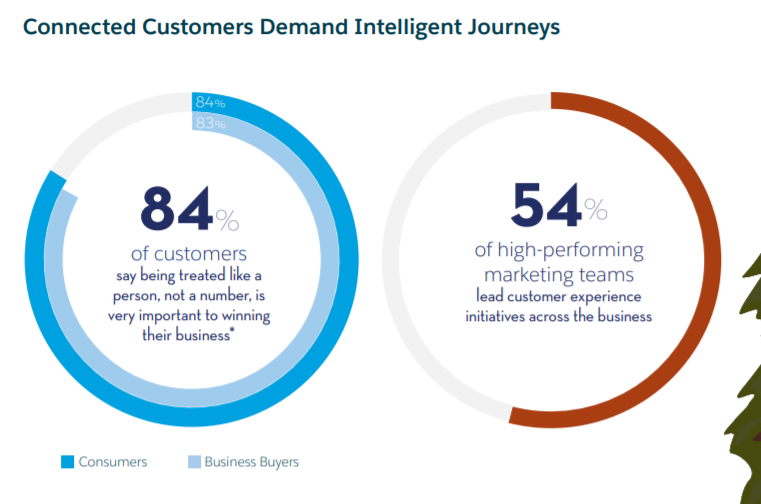Filters
Content Type
Topic
6 Ways to Use B2B Intent Data to Boost More Revenue

B2B intent data isn’t necessarily new, but it has become more accessible over the past few years.
As more and more B2Bs catch onto the idea that personalization is vital for generating leads, converting leads into customers, and retaining clients, the importance of intent data grows.
In fact, up to 85% of buyers say they’ll dismiss a company that doesn’t personalize the very first interaction. The first interaction!
Intent data helps you make sure you’re spending your marketing budget and efforts in the right places at every stage. Here are a few ways you can use it to boost your bottom line.
What Is the Definition of Intent Data?
When someone reads a blog on your website, you can reasonably assume they’re interested in a certain topic.
You can use that information alone for retargeting purposes – but it won’t deliver the conversion rates you want because you’re casting the net way too wide. With PPC or sponsored social posts, you’ll waste a ton of money – fast.
Just because someone expressed an interest in learning about personalization through a blog on your website, for example, it doesn’t mean they’re ready to buy your product – or would even consider it.
B2B intent data, by definition, tells you why someone is visiting your blog post – it tells you their intentions.
Intent data adds context and insight into your data. Intent data can come from either first-party (like your own website) or third-party sources. It can come from known visitors (like leads you’ve collected) or anonymous visitors.
How to Use B2B Intent Data to Drive More Revenue
You can use intent data to optimize every piece of your marketing strategy.
Of course, you’ll want to make sure you’re working with accurate data first. However, after you get that worked out, you can use intent data to create effective content, generate more leads through retargeting, and so much more!
1. Optimize Your Content Marketing Strategy with B2B Intent data
Surprisingly, many B2Bs haven’t latched onto intent data for building their content marketing strategies.
Most B2Bs use their content marketing for things like generating leads (70%), educating audiences (79%), and creating brand awareness (86%).
Intent data can remove plenty of the guesswork that goes into creating content. Since you’ll have a better idea of where your leads are at in the sales funnel, what types of content they like, which competitors they’ve researched, and other factors, you can take these pieces of information into consideration when you design your content strategy.
Understanding your leads and visitors on a contextual level is especially important for creating thought leadership pieces. 63% of senior-level execs say content is too generic while another 58% say it lacks originality. In other words, B2B content creators have plenty of gaps to fill and intent data can help.
2. Use B2B Intent Data to Prevent Customers from Jumping Ship
Intent data offers deep-level analysis not only on leads but on your current customers as well.
We all know that it costs more money to generate new leads over keeping current customers, right? What if you knew when your customers were checking out competitors and thinking of churning? Intent data can tell you.
Not only can intent data tell you when a customer visits a competitor’s website, but it can also help you boost the lifetime value of each customer. If one of your current customers is researching for a specific solution you offer but hasn’t completed a purchase, you’ll know exactly where to dedicate additional marketing resources.
3. Combine B2B Intent Data with Other Pieces of Information
Intent data on its own isn’t exactly super helpful. It doesn’t really matter which competitors a prospect has researched if you know nothing else about them, right?
The magic really starts to happen when you combine other pieces of information with intent data – specifically firmographics.
When you know which company a lead works for, their job role, their buying power, which competitors they’ve researched and for how long, THAT’S when you can start building an effective strategy.
4. Use B2B Intent Data for Effective Lead Scoring
Just because a lead fits into your target audience, that doesn’t mean they’ll buy something from you.
Intent data can help you fill lead scoring gaps.
Since you’ll be pulling data from multiple sources, you’ll be able to figure out if a lead truly has a need for your product and when they may possibly be in the market for it.
5. Develop an Effective Account-Based Marketing Strategy
Companies with an account-based marketing strategy generate 208% more revenue from their content marketing efforts.
By nature, account-based marketing is more relevant and personal – most B2Bs have already figured that part out.
However, intent data can kick it up another notch by removing many of the blind spots, so you’ll always know which accounts to target.
6. Use B2B Intent Data to Plan Events
Did you know that 91% of B2B professionals say that webinars are their favorite type of content?
Events – both online and off – are great tools for connecting with leads, exploring your audience, and building brand awareness.
For in-person events, you can use intent data to nail down the best locations and build a marketing strategy that targets the right accounts.
You can also use B2B intent data to create discussions and topics for your events since you’ll know what your audience is researching online and what they’ve already consumed.
Use Data to Boost Your Content Engagement by 305% Now
Hushly can help you harness the power of data to increase your lead conversions by 51% and content engagement by 305%! You’ll only pay for verified leads you generate through our system – we’ll never charge you fees for using our platform.
With Hushly, you can create a personalized experience for every website visitor with adaptive content hubs and self-nurturing landing pages. Plus, it takes almost no time to implement and is fully GDPR compliant.
See an adaptive content hub in action now to get started!
The post 6 Ways to Use B2B Intent Data to Boost More Revenue appeared first on Hushly.


